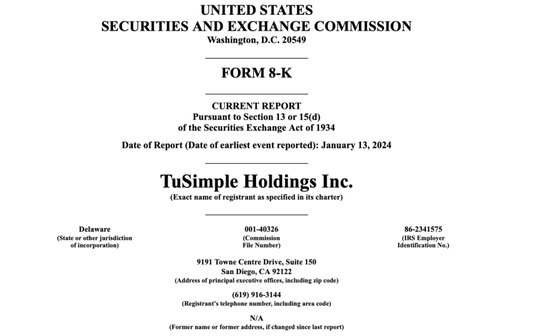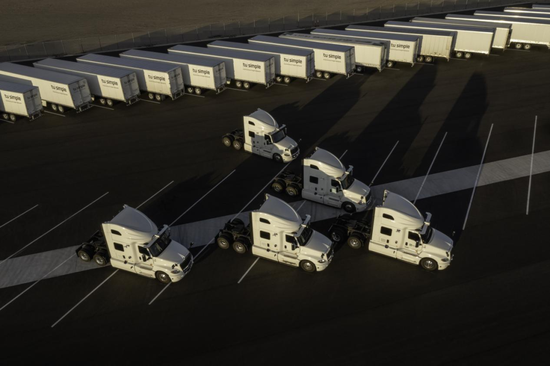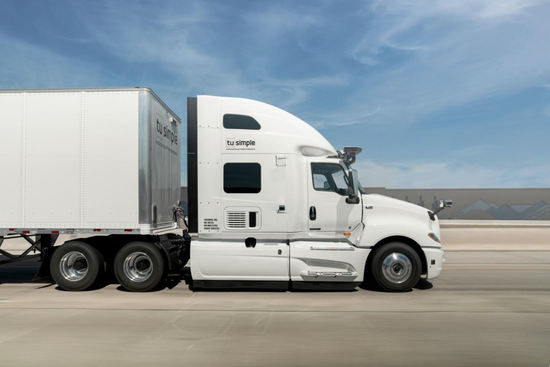Formerly known as the “world’s first stock of autonomous driving,” it has also become the “world’s first stock to be delisted from the global autonomous driving market.” On January 17th, local time, autonomous truck company TuSimple announced that it will be delisted from the NASDAQ in the United States and will terminate the registration of its common stock with the U.S. Securities and Exchange Commission. After the news was released, TuSimple’s stock price fell by 46.33% to $0.38 per share, with a market value of less than $100 million.
As for the reason for delisting, TuSimple Future stated that the special committee of the board of directors believes that delisting is in the best interest of the company and shareholders. Since TuSimple Future’s IPO in 2021, there have been significant changes in the capital market due to rising interest rates and quantitative tightening, affecting investors’ sentiment towards pre-commercial technology companies. This has led to a decrease in TuSimple Future’s valuation and liquidity, and more volatile stock price fluctuations. TuSimple Future believes that the benefits of maintaining a public company status no longer match the expenses. “We believe that as a private company, we can better transition than as a public company.” According to the plan, TuSimple Future will submit a delisting application to the SEC around January 29th. Barring any unforeseen circumstances, February 7th will be its last trading day. “Global leader in autonomous driving” announces delisting TuSimple Future is a self-driving technology company founded in 2015, headquartered in San Diego, California, and operating in the United States and Asia. In April 2021, TuSimple Future was officially listed on the Nasdaq in the United States.
As the “world’s first stock of autonomous driving”, TuSimple has had many highlights at the beginning of its listing. The company’s issue price was $40 per share, higher than the previous price range of $35 to $39. Driven by market enthusiasm, the company’s stock price once approached $80 per share, and its market value approached $17 billion. From being the leader to the current decline, what happened to TuSimple in just three years? In the industry’s view, commercialization falling short of expectations and executive “palace fighting” are important factors that have dealt a heavy blow to TuSimple. In the three years since going public, TuSimple has been unable to escape the “quagmire” of losses. The latest quarterly report shows that TuSimple’s gross loss in the first three quarters of 2023 was $500,000, research and development spending was $164 million, sales and marketing expenses were $83.7 million, and operating losses were $249 million, with an adjusted loss of $192 million. What has frequently appeared in major media headlines about TuSimple is not its performance, but the frequent rounds of “palace fighting”. In March 2022, the then chairman of TuSimple, Chen Mo, and CEO Lu Cheng, both resigned. In October 2022, the then CEO, president, and chief technology officer of TuSimple, Hou Xiaodi, was suddenly dismissed. Then Chen Mo and Hou Xiaodi combined their voting rights to quickly regain control. But the story doesn’t end there. The top-level continues to stage the “brother against brother” drama, with endless fighting and falling investor confidence. In December 2023, TuSimple submitted a report to the US Securities and Exchange Commission, stating that the company will lay off 150 employees in the US, about 75% of the total US workforce and 19% of the global workforce. Reports suggest that this layoff means TuSimple may completely exit the US market. After the layoff, TuSimple will have only 30 employees in the US, responsible for winding up the company’s US operations, gradually selling its assets in the US, and assisting the company in transitioning to the Asia-Pacific region. Prior to this, TuSimple had been advancing its business layout in the Asia-Pacific region. In June 2023, TuSimple obtained the first national license for road testing of driverless smart connected vehicles in Shanghai Pudong New Area, and completed the first unmanned test of automated heavy trucks on public roads. In addition, in June 2023, TuSimple officially announced its entry into the Japanese market and began testing autonomous driving on the Tomei Expressway in Japan. TuSimple remains optimistic about L4 driverless trucks. At the 2023 Shanghai Auto Show, TuSimple Chairman Chen Mo said: “We firmly believe that L4 driverless trucks can be successful.” The current issue in the market is the lack of close cooperation between autonomous driving companies and vehicle manufacturers. This is due to conflicting core interests, as both parties vie for dominance. This is why the L4 market is struggling to take off.
Chen Mo said that with the close cooperation of the entire vehicle factory, TuSimple will start initial batch commercialization in 2025 and will deploy in bulk in 2026. “For TuSimple, our software has accumulated to a level that can be scaled and commercialized, but we now lack close cooperation, which is the biggest problem.” Chen defaults to the true commercial operation of L4, which requires both the new forces of car making and the ability of driverless operation. Compared with passenger cars, the usage scenarios of commercial vehicles are simpler and face fewer complex road conditions. In the industry’s view, the commercialization of autonomous driving for commercial vehicles may be achieved earlier. At the previous China Electric Vehicle Hundred People’s Forum media communication meeting, Zhang Yongwei, Vice Chairman and Secretary-General of the China Electric Vehicle Hundred People’s Association, judged that the electrification and intelligence of commercial vehicles will accelerate transformation in sync. Zhang Yongwei said, “China is a big country for commercial vehicles, with a stock of more than 30 million vehicles, and fuel consumption, energy consumption, and carbon emissions account for more than half, making it the main source of carbon emissions. From the perspective of ‘dual carbon’ and the development of enterprises themselves, the electrification and new energy of commercial vehicles are necessary. After passenger cars enter the orbit of self-driving development, the focus of electrification should be on commercial vehicles to achieve their greening or new energy conversion.” Passenger cars are electrified first and then intelligent, while commercial vehicles now exhibit the characteristics of synchronous electrification and intelligence. Zhang Yongwei pointed out that intelligence is a necessity for commercial vehicles, going from two drivers to one driver, and from one driver to fully automatic driving. This is fun for passenger cars, but for commercial vehicles, it is about reducing costs. Zhang Yongwei called for attention to the progress of new energy in China’s commercial vehicle market, which has a stock of more than 30 million vehicles and an incremental market of more than 3 million vehicles. The Fangzheng Automobile Research Report believes that with the accelerated application of urban NOA, the continuous implementation of L3 and above level automatic driving systems, and the gradual maturity of hardware platforms and software algorithms, the second half of automatic driving is coming, and commercial vehicle automatic driving is entering the commercial operation stage.


